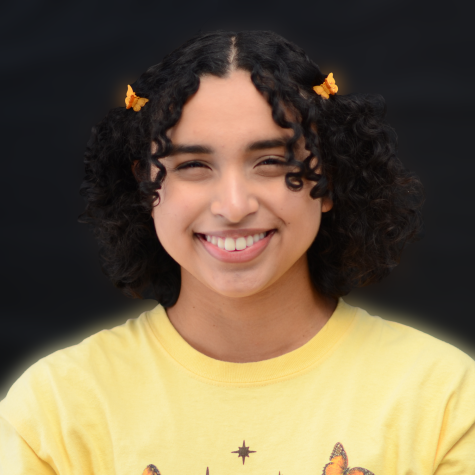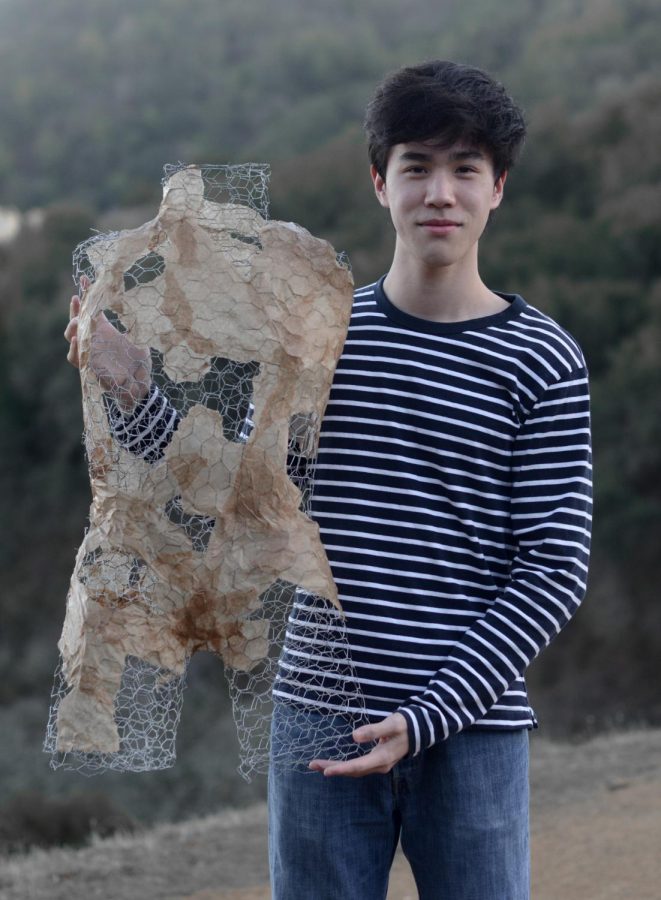Humans of Harker: Medium with meaning
Alex Zhai uses sculpture to spread awareness for social issues
Adjusting the position of his newest sculpture, Alex Zhai (12) steps back to admire his work. In front of him stands a large sculpture that resembles an eyeball, constructed from scraps of old technology no longer in use. Each of these pieces represents a part of the eye—the cover of a plastic fan for the pupil, shimmering wires for the optic nerve and a motherboard for the macula lutea. The nerves connect to a CD player, which represents the visual cortex in the brain. He watches the piece rotate round and round, mimicking a security camera.
After taking a sculpture course in his sophomore year, Alex discovered that he could use artwork to express how he feels about the world around him. One of his favorite sculptures was “Big Tech is Watching You: A Biological Eyeball inspired by George Orwell’s ‘1984’”. He often uses mixed media to address issues that he cares about like climate change and abortion to spread awareness through his audience.
“Sculpture is a way for me to communicate my ideas and beliefs in a way that resonates with a viewer,” Alex said. “I really enjoy the process of experimenting with a bunch of different materials because the medium that I work in, mixed media sculptures, is very open-ended.”
He used artwork as an instrument to contribute to the issues in the world he had been learning about and wanted to change. Russell Yang (12), who has been friends with Alex since sixth grade, supports his enthusiasm for sculpture as a creative outlet.
“Alex dedicates a lot of time and effort to things that he’s truly interested in,” Russell said. “He makes a lot of art, not for the accolades or competitions, but because it’s genuinely interesting to him.”
The authentic connection between his artwork and the issues that concern him allow him to create sculptures with meaning. Alex reflects on how his relationship with the environment growing up has inspired his artwork today.
“People should care more about the natural world. The reason I enjoy making sculptures, especially about nature, is because growing up in the Bay Area, [I have been] close to many different environments like the ocean, the mountains and the forest,” Alex said. “When people think of Silicon Valley, they think of high tech and industrialization, but the Bay Area also has so much nature around it, and that has impacted the way I’ve grown up.”
In addition to his artistic interests, Alex enjoys helping the people around him, whether it’s in class or out of class. One of his closest friends, Eric Zhu (12), reflected on how his friendship with Alex has affected him throughout high school.
“He’s really knowledgable on a lot of topics,” Eric said. “If I ever need advice on anything in my life, he’s the one I always approach because I know he has some kind of answer, and there’s some way he can help me out.”
In the summer before his junior year, Alex developed an interest in languages and decided to take a human ecology course. Since most students spend their summer trying to improve their resume, the teacher admired his choice to pursue the class due to his commitment to the issues he cares about. Growing up, his cultural background strengthened his value of language and inspired him to learn more about human ecology and language preservation.
“When people start teaching their kids English instead of their native language, these languages start to die off,” Alex said. “That was something that really impacted me. As someone who is trilingual, languages really connect me to my culture. Learning Mandarin was a way for me to speak to my relatives and learn about my family history.”
Throughout Human Ecology, upper school ecology teacher Chris Spenner enjoyed observing his enthusiasm for learning about the world around him. This year, he taught Alex in Physics C, where he observed how his positive attitude in class affected his relationships with other students.
“He is really patient with other people,” Spenner said. “Even if he sees the right answer, he’s not going to rush through getting his group to finish the problem. He’s going to help other people understand it. He cares about the learning of fellow students as much as his own learning.”
While Alex spends a lot of time helping his friends both inside and outside class, he also demonstrates a desire to help the larger community. Since middle school, Farah Hosseini (12) has supported him as he takes on multiple endeavors to pursue his interests. She admires how secure and confident he is in what he wants to do and the impact that his actions have on others.
“He takes charge of his life, and that’s something I really admire,” Farah said. “No matter who he surrounds himself with, no matter what courses he takes or what things he believes in, he’s so good at fitting them to his agenda and making his mark on our community rather than trying to adhere to what our community tells him to do.”
Through his work, Alex not only spreads a message to the community, but also reaches out and takes input from others. His dedication to preserving the world around him is a two way street, where he both inspires and is inspired by the causes he cares about and the people he interacts with.
“The main reason I do art is to communicate my ideas, so having someone there to talk to me about my ideas is part of the whole artmaking process,” Alex said. “The studio I work at is very collaborative, so each sculpture that I make is a product of the people I talk to throughout the process.”

Shinjan Ghosh (12) is the co-editor-in-chief of the TALON Yearbook, and this is her third year on staff. This year, she hopes to provide a welcoming environment...


















![“[Building nerf blasters] became this outlet of creativity for me that hasn't been matched by anything else. The process [of] making a build complete to your desire is such a painstakingly difficult process, but I've had to learn from [the skills needed from] soldering to proper painting. There's so many different options for everything, if you think about it, it exists. The best part is [that] if it doesn't exist, you can build it yourself," Ishaan Parate said.](https://harkeraquila.com/wp-content/uploads/2022/08/DSC_8149-900x604.jpg)




![“When I came into high school, I was ready to be a follower. But DECA was a game changer for me. It helped me overcome my fear of public speaking, and it's played such a major role in who I've become today. To be able to successfully lead a chapter of 150 students, an officer team and be one of the upperclassmen I once really admired is something I'm [really] proud of,” Anvitha Tummala ('21) said.](https://harkeraquila.com/wp-content/uploads/2021/07/Screen-Shot-2021-07-25-at-9.50.05-AM-900x594.png)







![“I think getting up in the morning and having a sense of purpose [is exciting]. I think without a certain amount of drive, life is kind of obsolete and mundane, and I think having that every single day is what makes each day unique and kind of makes life exciting,” Neymika Jain (12) said.](https://harkeraquila.com/wp-content/uploads/2017/06/Screen-Shot-2017-06-03-at-4.54.16-PM.png)








![“My slogan is ‘slow feet, don’t eat, and I’m hungry.’ You need to run fast to get where you are–you aren't going to get those championships if you aren't fast,” Angel Cervantes (12) said. “I want to do well in school on my tests and in track and win championships for my team. I live by that, [and] I can do that anywhere: in the classroom or on the field.”](https://harkeraquila.com/wp-content/uploads/2018/06/DSC5146-900x601.jpg)
![“[Volleyball has] taught me how to fall correctly, and another thing it taught is that you don’t have to be the best at something to be good at it. If you just hit the ball in a smart way, then it still scores points and you’re good at it. You could be a background player and still make a much bigger impact on the team than you would think,” Anya Gert (’20) said.](https://harkeraquila.com/wp-content/uploads/2020/06/AnnaGert_JinTuan_HoHPhotoEdited-600x900.jpeg)

![“I'm not nearly there yet, but [my confidence has] definitely been getting better since I was pretty shy and timid coming into Harker my freshman year. I know that there's a lot of people that are really confident in what they do, and I really admire them. Everyone's so driven and that has really pushed me to kind of try to find my own place in high school and be more confident,” Alyssa Huang (’20) said.](https://harkeraquila.com/wp-content/uploads/2020/06/AlyssaHuang_EmilyChen_HoHPhoto-900x749.jpeg)



